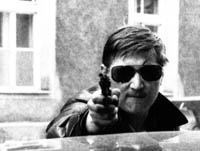
Rainer Werner Fassbinder in seinem ersten Spielfilm LIEBE IST KÄLTER ALS DER TOD (1969)
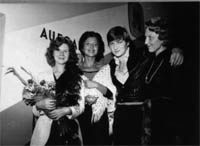
Berlinale 1974, FONTANE EFFI BRIEST
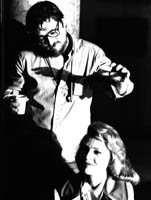
Rainer Werner Fassbinder und Hanna Schygulla bei den Dreharbeiten zu LILI
MARLEEN (1980)
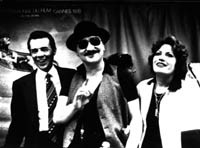
Filmfestspiele Cannes 1978, DESPAIR – EINE REISE INS LICHT
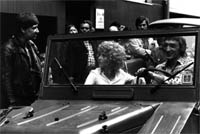
Dreharbeiten zu ACHT STUNDEN SIND KEIN TAG, 1972
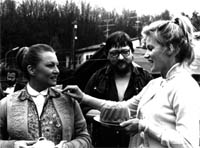
Rainer Werner Fassbinder mit Karin Baal und Barbara Sukowa bei den Dreharbeiten zu LOLA, 1981
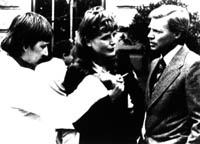
Dreharbeiten zu MARTHA
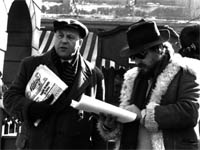
Dreharbeiten zu BERLIN ALEXANDERPLATZ, 1979/80
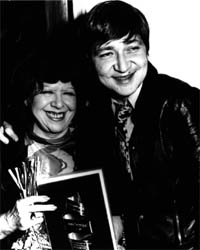
Bundesfilmpreis 1974, ANGST ESSEN SEELE AUF
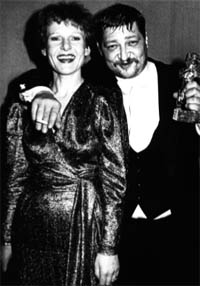
Berlinale 1982, Goldener Bär für DIE SEHNSUCHT DER VERONIKA VOSS
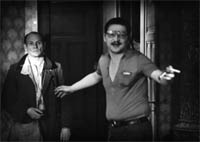
Dreharbeiten zu DIE EHE DER MARIA BRAUN, 1978
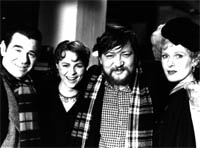
Dreharbeiten zu DIE SEHNSUCHT DER VERONIKA VOSS, 1981
The Forward-looking Traditionalist
Wolfram Schütte
In the mid-1960s, when Bertolt Brecht’s Epic Theater dominated the German-speaking stage, Max Frisch spoke of Brecht possessing the “striking ineffectiveness of a classic.” The playwright, who agitated for social change in epic parables written for a “theater of the scientific age,” was accepted by society and integrated into it, and was thus a classic: immobilized. Rainer Werner Fassbinder, who attained comparable artistic status in the German-language cinema between 1969 and 1982, and whose public image dominated the scene during those fourteen years, neither became a classic nor did he achieve outstanding success. But was he ineffective?
Looking down at the lamentable depth of contemporary German cinema from the aesthetic summit of his late works, after the 1978 DESPAIR, and from the paradigmatic validity of his “German” subjects, from KATZELMACHER to VERONIKA VOSS, one will scarcely discern anything in the ten years since he died except his disappearance: not only the dissolution of Fassbinder as a steady presence, somewhat like the basso continuo in the polyphony of the German cinema that came after him, but the general decline of all aesthetic principles that blossomed in the richness of his vast oeuvre.
Fassbinder’s oeuvre, like that of other directors of the New German Cinema, could not have come about without the cooperation of the public television stations. Yet he, as did no other, realized the implications of the specifically German production situation. His artistic productivity, which resulted in an oeuvre of forty-four film and television productions, coincided with the vigorous appropriation and exploitation of every possible source he could draw from. He alone gave exuberant life to the declaration on which the Young and the New German Cinema staked its claim, that “Opas Kino” (grandpa’s cinema) was dead. lf there was a German Autorenfilm (auteurist cinema) – and certainly the genius-cult of West German Sturm und Drang in the 1960s and 1970s did produce the works of Kluge and Wenders, Schroeter and von Praunheim, Herzog and Syberberg, Thome and Straub – Fassbinder’s far-reaching activities were at the center of it.
His genius – probably the only one of the postwar German cinema – is evident not only in his work but also in the freewheeling activity and inspirational vitality with which he combined film and film production, television and television production into a comprehensive, always expanding, retrospective, and progressive unity. His utopian vision, which he very nearly made come true, was to merge the division of labor of the studio system with the author’s personal creativity through an amalgamation of group dynamics and individualistic work processes. He was producer-tycoon and star director all in one; and to feed the artistic imagination that spurred him on, he needed to make sure that he kept both feet on the ground. This he first achieved with the team of the Action Theater, in the group which evolved from it, and later in various teams of actors, cinematographers, musicians, set designers, and studios.
The auteurist film, whose emergence accompanied the decline ofthe “producer film” that could no longer compete with television in the domestic market, was unmistakably a harbinger of the antiauthoritarian movement and an expression ofthe international student and youth revolt, which in the Paris of May 1968 had its storming of the Bastille and, shortly after, its Thermidor and Waterloo. Euphoria over a new lifestyle was rapidly succeeded by depression over its failure – more quickly, in keeping with the modern process of acceleration, than at the turn of the eighteenth to the nineteenth Century. The socialist-liberal coalition; the ban on employment of radicals in state schools and public institutions in general; the German Director’s Theater of Peter Stein, Claus Peymann, and Hans Neuenfels; and the New German Cinema were parallel events, riddled by the ricochets of Baader-Meinhof terrorism.
Rainer Werner Fassbinder, born in 1945, was not one of the initiators of the Oberhausen Manifesto. He did not subscribe to their programmatic approach, in which German postwar film history was understood largely as a continuation of UFA films (Universum-Film AG, or UFA, was the principal film company in Germany before 1945) and as a product of the Adenauer-era restoration. Nor did he adopt Alexander Kluge’s idea of a conscious return to authentic, documentary-oriented contemporary film subjects. Fassbinder, as the youngest, had only recently become one of the West German filmmakers, and he was and always remained an outsider. His roots were in the theater rather than in documentary, industrial, art, or television filmmaking. In the theater, as director, actor, and author, as spiritus rector, he gathered around him a troupe.
In the course of his filmmaking career, Fassbinder’s involvement with the theater ended – definitely by 1974-75, when he foundered with the management of the TAT (Theater am Turm) in Frankfurt, which he had tried to develop into a base for parallel film production. He nevertheless succeeded where comparable movie talents, like Peter Stein and Luc Bondy, had failed, in finding the royal road to developing his artistic potential in film. The theater of Stein, Bondy, and Hans Neuenfels repeatedly cast envious glances toward the cinema, whose character as a total work of art these directors evoked on stage; yet only with Fassbinder did the theater open its eyes wide, because in his films it plays a vital role (as it does in those of Visconti).
With one other German-speaking artist, namely Peter Handke, whose often-professed love of the cinema he has frequently brought to the work of his spiritually congenial friend Wim Wenders, Fassbinder shared a talent that the stage directors Stein, Neuenfels, and Bondy did not have at their disposal: an innate narrative creativity. It is this that accounts for Fassbinder’s unique status, the concentrated density of his filmic oeuvre, and it is this – despite craftsmanly equivalents, for example in the work of Volker Schlöndorff or Reinhard Hauff – that fundamentally sets him apart. He is also set apart from the storytellers of the New German Cinema insofar as this teller of his own tale was able to handle his own material and subject matter in an aesthetically far-more-intimate and personal way, or, to paraphrase Kleist, he was able to recognize the cinematographic potential of his stories, “formulating his ideas while he was talking”; in short, he did not think of storytelling in film as adapting literature to the medium of vision and sound but was able to think in cinematographic terms from the start.
This genuine filmic creativity comprehends the “straightaway” of Raoul Walsh and Michael Curtiz in the same sovereign manner as the lighting direction of Josef von Sternberg, the color dramaturgy of Douglas Sirk, and Joseph L. Mankiewicz’s complex narrative strategies (as a creative counterpart, for instance, of the Döblinesque montage technique in BERLIN ALEXANDERPLATZ). This, in particular, made possible Fassbinder adaptations of literary sources (as with EFFI BRIEST, THE STATIONMASTER’S WIFE, QUERELLE), where – each in its own way – no residue of the adaptation process remains to disturb or irritate.
Nevertheless, the theater from which he grew and eventually escaped shaped the director’s style, determined the stringency of his storytelling and the visual concentration of his work. The stage as the scene of action, as the conceptual abstraction of a lived life, returns even in apparently naturalistic movies, such as THE MERCHANT OF FOUR SEASONS, ALI: FEAR EATS THE SOUL, FEAR OF FEAR, or I ONLY WANT YOU TO LOVE ME, through a nonnaturalistic mode of speech. He signals distance, irritation with realistic events, which are – to a greater extent than stage scenery would permit – charged with additional narrative value through a metaphoric use of camera angles. This is why one finds more than one sees and hears in Fassbinder’s “realistic works”; and this is what distinguishes his films from the numerous “realistic” movies about the workers’ world, by which a part of the New German Cinema turned its attention, polemically and functionally, to the everyday lives of the working-class petit bourgeoisie.